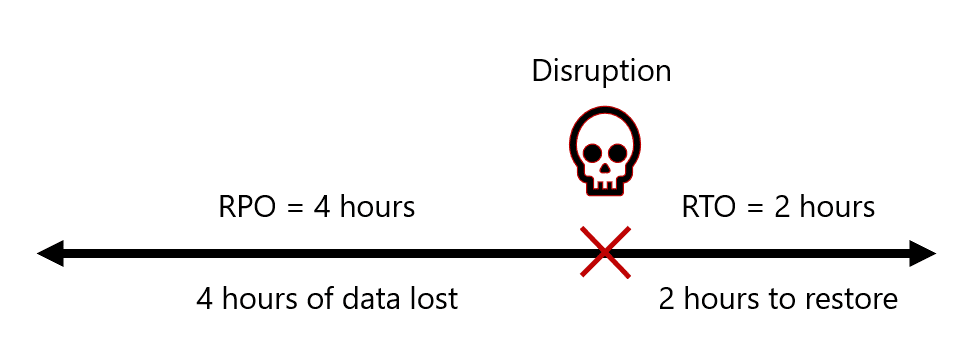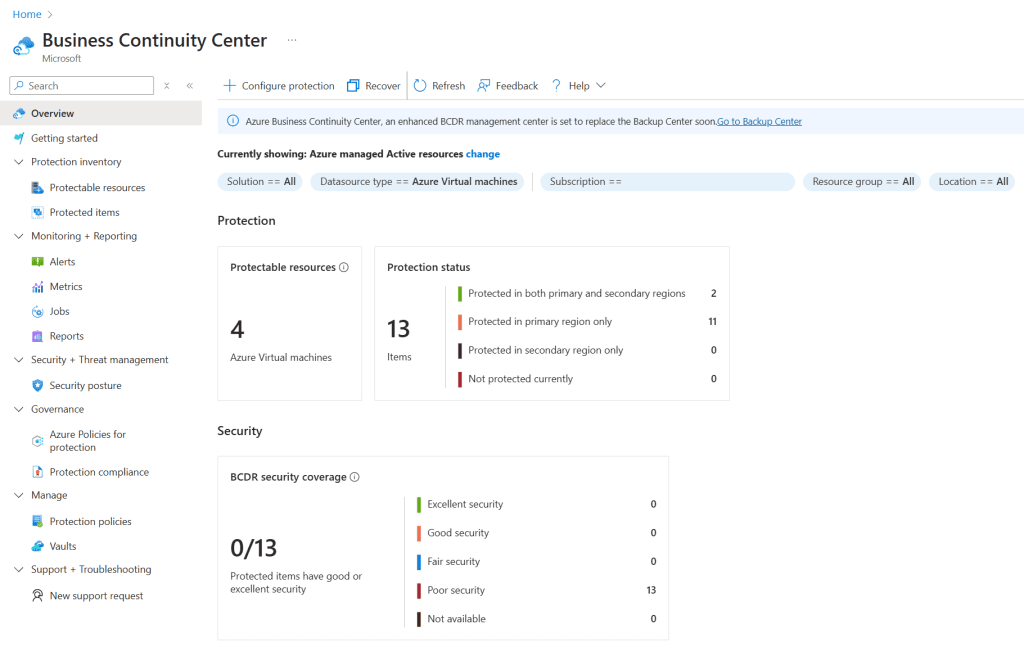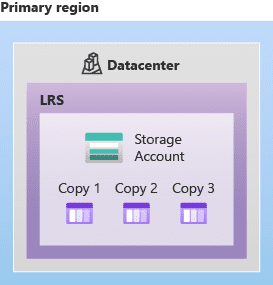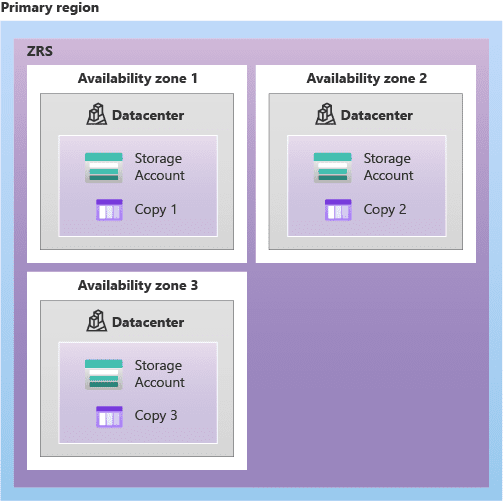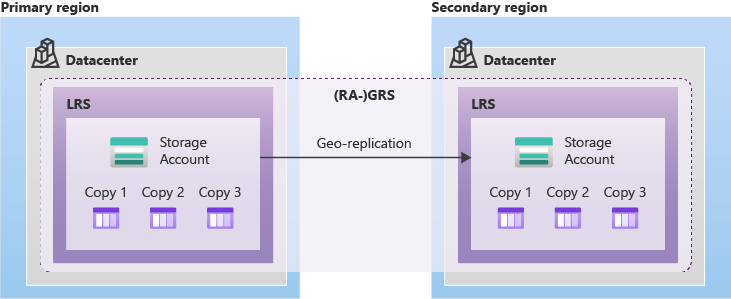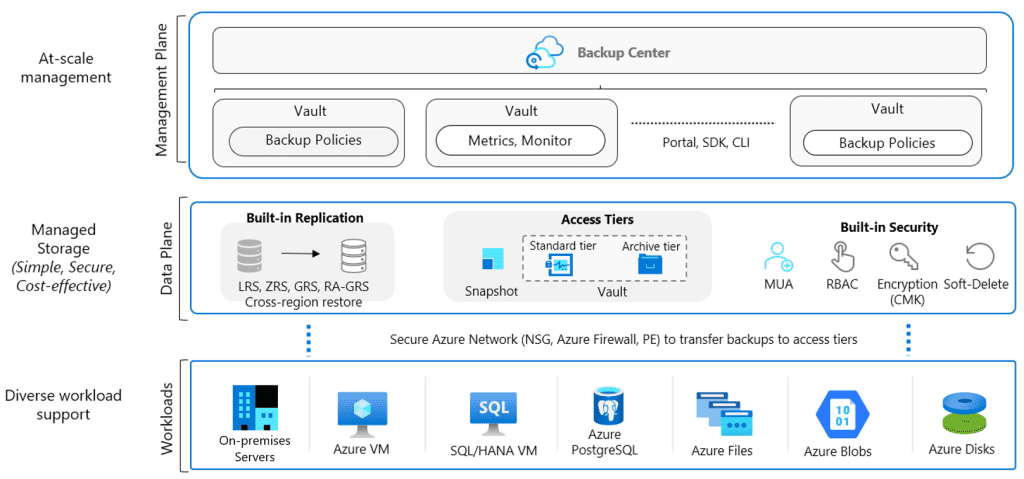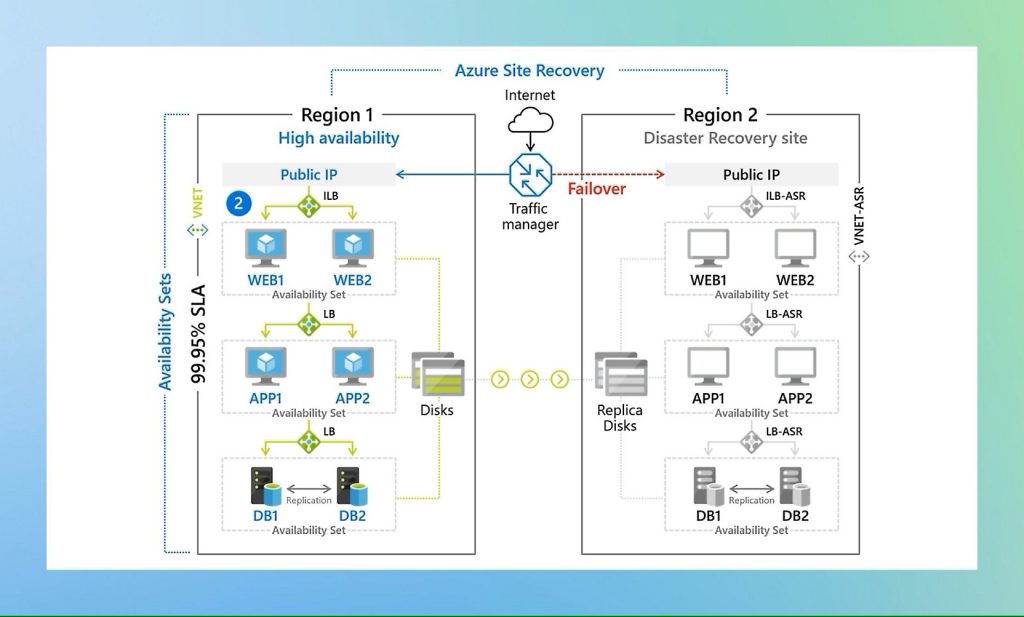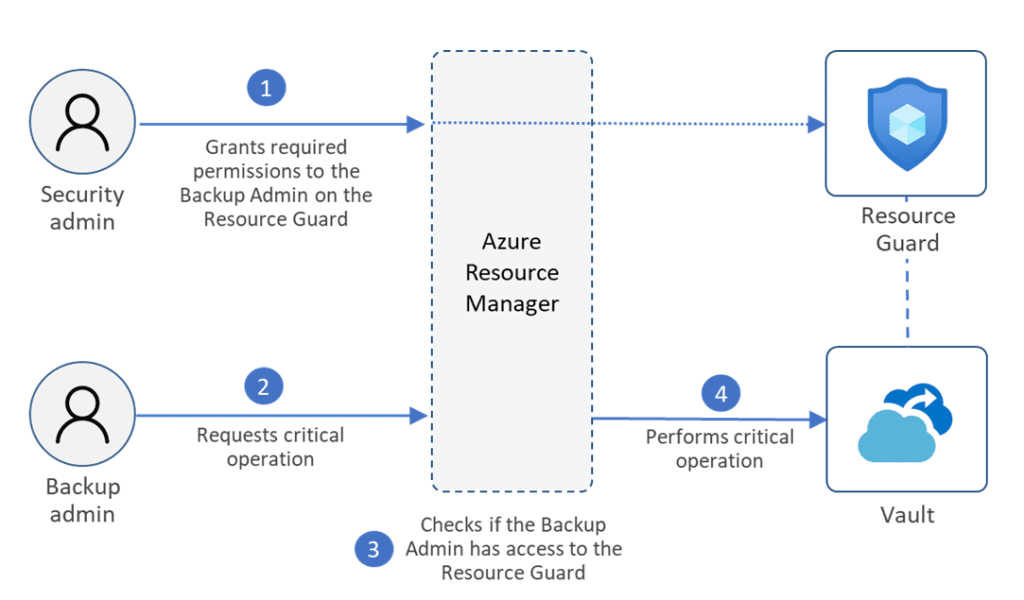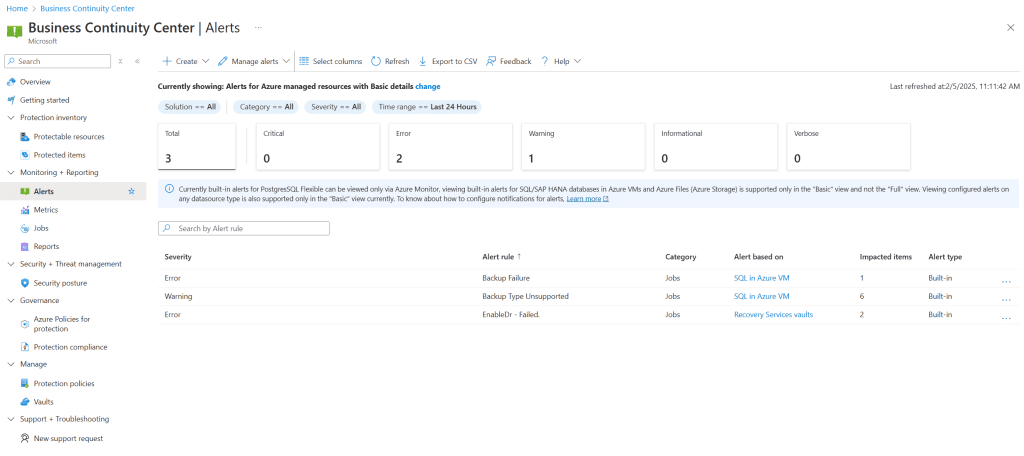Introduction
As enterprises grow, so does the complexity of their data management needs. Ensuring a robust backup strategy is pivotal to maintain data integrity, availability, and compliance. Azure Backup offers diverse solutions tailored for enterprise needs, including Recovery Services Vault and Backup Vault. This article delves into the nuances of using these vaults, enabling backups at scale, and implementing additional security layers.
Basic Concepts for Choosing the Right Service
Before diving into the details of Azure Backup, it’s essential to understand some fundamental concepts related to business continuity and disaster recovery:
Recovery Point Objective (RPO)
The RPO is the maximum acceptable amount of data loss measured in time. It indicates the point in time to which data must be recovered after a disruption. For instance, if an enterprise has an RPO of 4 hours, it means that in the event of a failure, they are willing to lose up to 4 hours of data.
Recovery Time Objective (RTO)
The RTO is the maximum acceptable amount of time to restore services after a disruption. It defines the target duration within which a business process must be restored to avoid unacceptable consequences. For example, if the RTO is 2 hours, the business should aim to recover their services within that time frame.
Mean Time to Repair (MTTR)
MTTR is the average time required to repair a failed component or system and restore it to operational status. This metric is critical for understanding the efficiency of the recovery process and planning for future disruptions.
Event Description | Event Date | Start Time | End Time | Repair Time |
Network Outage | 2024-06-16 | 10:00 AM | 12:00 PM | 2 hours |
Database Failure | 2024-06-23 | 02:00 PM | 04:30 PM | 2.5 hours |
Application Crash | 2024-07-21 | 09:00 AM | 10:15 AM | 1.25 hours |
Server Downtime | 2024-09-12 | 11:00 AM | 01:30 PM | 2.5 hours |
Security Breach | 2024-11-20 | 03:00 PM | 05:45 PM | 2.75 hours |
Total Repair Time: 11 hours
Number of Repair Events: 5
Mean Time to Repair (MTTR): 11 hours / 5 events = 2.2 hours
Mean Time Between Failures (MTBF)
MTBF measures the average time between failures of a system or component. It is an indicator of the reliability and stability of the system. A higher MTBF suggests that the system is less likely to fail, which is crucial for maintaining business continuity.
To evaluate the reliability and stability of a system, we calculate the Mean Time Between Failures (MTBF). For this example, we chose the period from 2024-06-01 to 2024-12-31, which spans 214 days of continuous operation. This period provides a comprehensive view of the system’s performance over an extended timeframe. The MTBF is calculated by dividing the total working time minus the total breakdown time by the number of breakdowns. A higher MTBF indicates a more reliable system, as it suggests longer intervals between failures.

Event Description | Event Date | Start Time | End Time | Repair Time |
Network Outage | 2024-06-16 | 10:00 AM | 12:00 PM | 2 hours |
Database Failure | 2024-06-23 | 02:00 PM | 04:30 PM | 2.5 hours |
Application Crash | 2024-07-21 | 09:00 AM | 10:15 AM | 1.25 hours |
Server Downtime | 2024-09-12 | 11:00 AM | 01:30 PM | 2.5 hours |
Security Breach | 2024-11-20 | 03:00 PM | 05:45 PM | 2.75 hours |
Total Working Time: 5136 hours
Total Breakdown Time: 11 hours
Number of Breakdowns: 5
Mean Time Between Failures (MTBF): (5136 hours – 11 hours) / 5 breakdowns = 1025 hours
These metrics are vital for evaluating the overall business continuity and disaster recovery strategy. Understanding RPO, RTO, MTTR, and MTBF helps organizations choose the right backup and recovery solutions tailored to their specific needs.
Understanding Azure Backup Storage Types
Azure Backup primarily uses two types of storage vaults:
- Recovery Services Vault: Provides a unified storage solution for various Azure services, including virtual machines, SQL databases, and more. It supports redundancy options like GRS (Geo-Redundant Storage), ZRS (Zone-Redundant Storage), LRS (Locally Redundant Storage), and RA-GRS (Read-Access Geo-Redundant Storage).
- Backup Vault: A storage repository designed specifically for Azure Backup. It offers similar redundancy options and integrates smoothly with Azure Backup services.
Standard and Archive Tiers
Azure Backup offers two main storage tiers to optimize costs:
- Standard Tier: This tier is used for active backups that need to be readily accessible. It supports LRS, ZRS, GRS, and RA-GRS redundancy options.
- Archive Tier: This tier is designed for long-term data retention with lower costs. Data can be automatically moved to this tier after a specified time, making it a cost-effective solution for older backups.

Business Continuity Center
The Business Continuity Center in the Azure portal offers an overview of protectable resources and already protected items. It’s a crucial tool for enterprises to monitor and manage their backup strategy efficiently. The portal provides options for “backup” and “site recovery,” streamlining the process but sometimes obscuring the differences between Recovery Services Vault and Backup Vault.
Redundancy Options
Azure offers several redundancy options to ensure data durability and availability:
- LRS (Locally Redundant Storage): Replicates data within a single data center.
- ZRS (Zone-Redundant Storage): Distributes data across multiple availability zones within a region.
- GRS (Geo-Redundant Storage): Replicates data across different geographic locations, providing the highest level of durability.
- RA-GRS (Read-Access Geo-Redundant Storage): Offers the same durability as GRS, but with the added benefit of read access to the secondary region.
Cost-Effective Vault Tiers
To optimize costs, Azure Backup allows automatic movement of data into an archive tier after a specified time. This tiering strategy can significantly reduce storage costs, especially for long-term data retention.
Incremental and Differential Backups
Azure Backup supports both incremental and differential backups, providing flexibility in how data is protected and stored. Here’s how they differ:
- Incremental Backups: These backups only capture changes made since the last backup, whether it was a full or incremental one. This method minimizes storage usage and speeds up the backup process as only the modified data is saved.
- Differential Backups: These backups capture all changes made since the last full backup. While they can grow larger over time as more data changes, they provide a faster restore option compared to incremental backups, as fewer backup sets need to be processed during recovery.
Enabling Backup at Scale
A significant challenge for enterprises is implementing a consistent backup strategy across their entire tenant. Here are some best practices:
Centralized Vault Strategy
Initially, it might seem practical to have a single central vault for all backups. However, due to data boundary reasons, a backup or recovery services vault must reside within the same subscription and location as the protectable items. This means enterprises will need multiple vaults if they operate across different locations or subscriptions.
Policy Assignment
To manage backups at scale, consider assigning backup policies at the management group level. This allows for a more streamlined approach to policy enforcement across multiple subscriptions and resources.
Vault-Specific Settings
One limitation is that vault policies, such as standard or enhanced, cannot be duplicated across vaults. Each vault requires unique settings, which can complicate enforcement of consistent rules. Automating policy creation and management through scripts or Azure Policy can mitigate this challenge.
Azure Site Recovery
Azure Site Recovery is another crucial component of a comprehensive backup strategy. It offers disaster recovery solutions by replicating workloads running on physical and virtual machines (VMs) from a primary site to a secondary location. This ensures business continuity in the event of a major outage.
Differences, Features, and Pricing
- Differences: While Azure Backup focuses on protecting data by creating backups, Azure Site Recovery emphasizes disaster recovery by replicating entire VMs or physical servers.
- Features: Site Recovery includes continuous replication, automatic recovery plan execution, and health monitoring. It supports both application-consistent and crash-consistent recovery points.
- Pricing: Pricing for Azure Site Recovery is based on the number of instances protected and the storage used. It’s essential to review the latest Azure pricing page for accurate cost details.
Resource Guard
Resource Guard is an essential layer of security for Azure Backup. It protects backup data from accidental or malicious deletion by requiring additional authentication for critical backup operations. This feature enhances the overall security posture of your backup strategy, ensuring that data remains secure and recoverable.
Alerts and Metrics
Monitoring and alerting are crucial for maintaining a reliable backup strategy. Azure Backup offers built-in alerts within the Business Continuity Center to notify users of backup job failures, critical errors, and other important events.
Built-In Alerts
- Azure Backup automatically provides alerts for job failures, missed backups, and critical errors, ensuring prompt action can be taken to resolve issues.
Custom Alerts
- Users can configure custom alerts to tailor notifications to their specific needs. These alerts can be set up through Azure Monitor, providing flexibility in monitoring backup activities across different resources and vaults.
Service Level Agreements (SLAs)
Service Level Agreements (SLAs) are critical in understanding the reliability and performance guarantees provided by Azure Backup services. Here are the key SLAs for different Azure Backup services:
- Azure Backup: Offers an SLA of 99.90% for backup and restore operations, ensuring high availability and reliability for critical data protection tasks.
- Azure Site Recovery: Provides an SLA of 99.95% for failover and replication, ensuring consistent and reliable disaster recovery capabilities.
Conclusion
Implementing a centralized backup strategy at enterprise scale requires careful planning and execution. By leveraging Azure Backup’s diverse storage solutions, redundancy options, cost-effective tiers, and robust security features, organizations can ensure their data is protected and easily recoverable. Consistent policy management and automation are key to maintaining a scalable and efficient backup strategy. Additionally, incorporating Azure Site Recovery enhances disaster recovery capabilities, ensuring business continuity in the face of potential disruptions.

